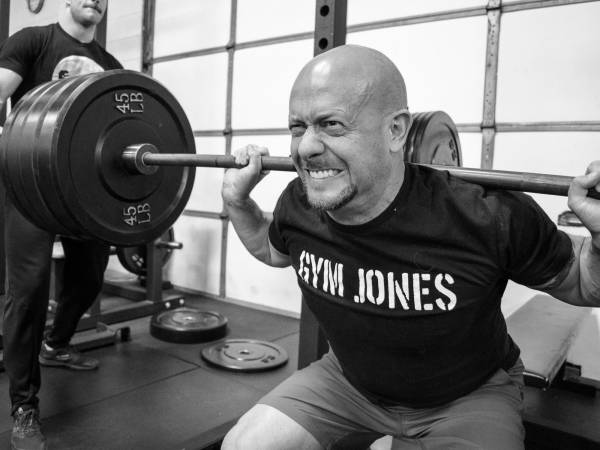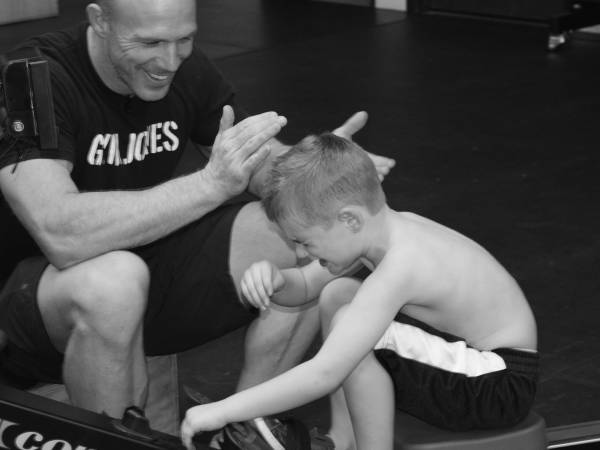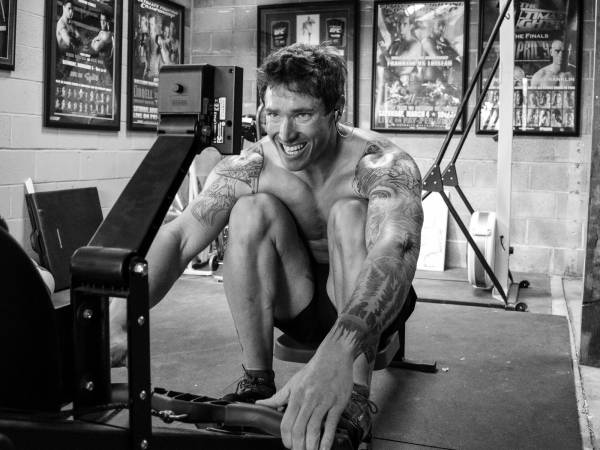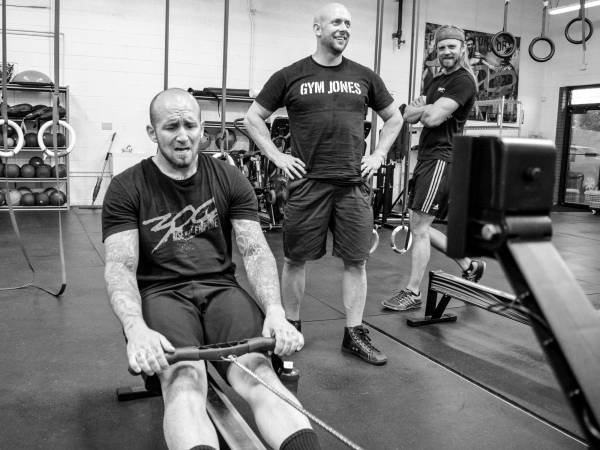When it comes to hard work, perspective is everything. Do you work as hard as you think you do? When you go the gym, are you giving it everything you have or are you just showing up?
That’s me. How much effort do you really put in when you get under the bar?
If you want to achieve your goals, then you have to do more than just show up. You have to work, to grind, and to suffer. Just because you showed up doesn’t mean you’ve put in an honest day’s work. And it certainly doesn’t mean you’ve done something to make yourself better.
Nothing in Life Is Easy
We are inundated with infomercials and training systems promising radical, life-changing results for three easy payments, little time commitment, and little effort. We have been led to believe we will be successful by paying some money and putting in a minimal amount of work. How can that be true? And how many times have you already tried that shortcut and failed?
Nothing in life comes easily. If it does, you don’t want it because chances are it comes with a catch. It may be the road less traveled, but the harder road is always the road to take, and the right way is always the best way.
“[I]n any discipline the single greatest determinant of success is the time a person is willing to give his or her goal.”
In the realm of fitness, most people blame external forces when they don’t achieve their goal. They make excuses for their poor showing. Time, equipment, lack of knowledge, poor genetics. They rarely look within and blame the real culprit – themselves.
The most successful people in the world share something in common: they are willing to make sacrifices where others are not. They are willing to do whatever it takes. There are no excuses. They embrace hard work, they are willing to give everything they have, and they are willing to suffer. We could learn something from these people.
3 Different Ways to Suffer
1. Working on Weaknesses
Often in the gym, we will gravitate to the exercises we like. In general, we like them because they are easy or make us feel good. Does this help us improve, though? How many of us work on our weaknesses regularly?
A weakness develops because we have neglected to work certain attributes or ignored certain exercises (probably because we dislike them). If I were to give one piece of advice regarding training, it would be to make a list of your strengths and weaknesses and then for the next month only work on your weaknesses.
You’ll be shocked at the progress you will see if you do this. It won’t be a fun month and it will be filled with all kinds of exercises you likely hate, but I can guarantee results.

Don’t deny yourself progress by taking the easy path.
2. Doing More Work
The best athletes in the world train all the time. It is what they do. In fact, in any discipline the single greatest determinant of success is the time a person is willing to give his or her goal.
Do you think Michael Phelps became the best swimmer in the world by swimming four hours a week? Do you think Rich Froning is the best CrossFit athlete in the world because he trains only once or twice a week? How many hours of practice did Michael Jordan need to complete to become the best basketball player of all time?
The best people in the world practice all of the time. It is their life. They became the best by being willing to put in more time and quality practice than anyone else.
So a key to improving is to do more work. If you are showing up to the gym three days a week, it simply isn’t enough. If you want to achieve your goals, then you need to be in the gym every day. There are no excuses, and it isn’t about finding more time. It is about making the gym a priority. Yes, I get it that you are busy, but there is always more time available. You just need better time-management skills or you need to be willing to make a sacrifice.
“There is nothing wrong with hurting a little. There is nothing wrong with being in a little discomfort.”
There are 168 hours in a week. If you sleep eight full hours a night, seven days a week, that adds up to 56 hours. You still have 112 hours left – and are you really sleeping eight hours a night anyway? (You should be.)
Let’s say you also work twelve-hour days, five days a week. That is working 9:00am to 9:00pm, Monday through Friday. The total work is sixty hours. Subtract that from your 112 hours and you still have 62 hours left to play with. You should be able to commit at least five to ten of those hours to train.
Even if you trained for ten hours, you’d still have 52 left. If you think you don’t have enough time, then what are you doing with those 52 hours? Watching TV, playing with your phone, checking your Facebook?
If you really think you don’t have enough time to train, then do something for me. Every time you check your text messages, Facebook, or Instagram do ten burpees. You’ll quickly see how much of a time suck these things are.
Yes, you may have to suffer by giving up some other things you enjoy. But the bottom line is that you need to sacrifice, give a few things up, make more time, and get more work done.
Or you can be happy being mediocre. Your choice.

Teaching my son to push past his limits and enjoy the process of hard work.
3. Working Harder
Just walking through the gym doors and scanning your membership card or taking part in a class doesn’t ensure you will be successful. You need to work for your success. You need to suffer for it. But many people have no idea what genuine, hard work looks like. They show up to the gym and go through the motions.
When you are at the gym – go for it. Don’t go halfway. People fall into the trap of doing “junk intensity.” That is when you are working hard enough to beat yourself down, but not hard enough to facilitate a meaningful change in your fitness.
“Most people really don’t know what “all out” is. They think they know, but they don’t. Here are a few tests that will teach you how to hurt and what your limits are.”
To improve, you must push yourself past your perceived limits. You must put yourself in an uncomfortable position. You must feel some pain. You need to sweat and you need to bleed. Training should never be easy. You should leave the gym mentally and physically exhausted. The goal each day is to experience “the moment.” That point in a workout where you don’t know if you can continue.
If a workout is hard enough, you will know it. During a workout you should think four things:
- “I’m not going to make it.”
- “I want to quit.”
- “I’m going to die if I keep going.”
- “I’d rather just die than finish this.”
That is the effort required. Anything less is not acceptable. Learn to hurt and learn to suffer.
Strategies and Tests to Help You Suffer
I can’t help you work on your weakness or create your desire to make more time. That is on you. I can help you figure out what real, genuine hard work is.
Most people really don’t know what “all out” is. They think they know, but they don’t. Here are a few tests that will teach you how to hurt and what your limits are. In exploring those limits, you will learn how to suffer.

Try one of the following tests of physical and mental endurance to increase your capacity for suffering.
1.5 Mile Run for Time
Plan a mile and half course and run it as fast as humanly possible. This isn’t a walk, this isn’t a jog. The entire effort must be a push. If you don’t want to collapse at the end of this, then you didn’t go hard enough.
My advice is to do this every week for six weeks straight. On the first effort, go as fast as you can. Then, each subsequent week, your goal will be to set a new personal best and beat your previous time. By doing this, you will ensure that you hit your limits and force yourself to suffer to burst through them. By the end of six weeks, you will know what it is to go hard.
Good goal: 9 minutes for the average runner.
2,000m Row for Time
This works the same as the mile and a half run, but on a rower. Just program 2000m into the rower and row it as fast as you can. I love the rower because the computer is staring you in the face. You can’t run and you can’t hide.
Here’s a tip to gauge intensity: if you don’t want to quit at the halfway point, then you aren’t going hard enough. If you do this right you’ll know what it is like to suffer.
Good goal: 7 minutes for the average person.
60-Second All-Out Run, Row, Bike, or Ski
If you give it everything you have, a minute all-out is about a minute too long. To do this, you need to be in the right frame of mind. Try to break the machine you are using. You need to fight, scratch, and claw for every extra meter or calorie. Give this everything you have.
If you thought you were working hard during your hour at the gym, this drill will teach you that you were wasting 59 of those minutes.

The rowing machines in our gym have claimed the spirit of those who test their limits with the all-out sprint.
Death by Burpees
This is a simple test that can be done anywhere:
- Set a clock and let it run.
- During the first minute, do one burpee.
- During the second minute, do two burpees.
- In the third minute, you’ll do three.
- By the fifteenth minute, you’ll be doing fifteen.
Eventually, you will come to a point where you can’t or won’t continue. Either way you’ll learn to suffer.
Good goal: Hitting the SEVENTEENTH minute.
Suffering Isn’t All Bad
Don’t let the idea of suffering frighten you. So many people want to take the easy way out. But when it comes to training, there is no easy way. The harder path is the best path.
There is nothing wrong with hurting a little. There is nothing wrong with being in a little discomfort. You may think this doesn’t seem fun, but you’ll learn to enjoy it. You’ll learn there is nothing more fun than achieving your goals. It will make all that suffering worth it.
Check out these related articles:
- Do Athletes Have a Higher Pain Tolerance?
- 7 Injury Myths You Need to Stop Believing
- Understanding the Brain Is the Key to Being Pain-Free
- What’s New On Breaking Muscle Today
Photos courtesy of Gym Jones.






